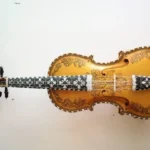
The tuba is the lowest-pitched musical instrument in the brass family. As with all brass instruments, the sound is produced by lip vibration, or a buzz, into a large mouthpiece. It first appeared in the mid-19th century, making it one of the newer instruments in the modern orchestra and concert band.
The Tuba was invented by Willhelm Friedrich Wieprecht and Johann Gottfried Moritz in September 12, 1835.
In Latin the word ‘tuba’ means horn or trumpet.
Tubas were introduced into the orchestra to replace the ophicleide, a keyed bugle of the Renaissance age.
A tuba’s body consists of the mouthpiece, main tube, valve tube, valves, and the bell.
There was nothing wrong with the ophicleide that required its replacement in the orchestra. Instead, a successful marketing campaign representing the Tuba as a more up-to-date instrument forced its replacement.
The tuba’s sound is deep and rich, and it is the lowest-pitched instrument on the brass family.
The tuba is capable of being more than the bass instrument that reinforces the bass string and woodwinds.
A tuba is used to produce the brass section of an orchestra’s bass notes. They are usually found in jazz music and in brass bands as well.
Early tubas were altered to possess forward-facing bells in order to make recording the sounds of the instruments easier.
The tubist holds the instrument upright while playing, which is different than the way trombones or trumpets are held.
Tubas come in a variety of pitches ranging from the deep bass of the extremely rare subcontrabass tuba to the much higher pitched tenor tuba.
Tubas became a member of symphony orchestras in the mid-1800s.
Marching bands use a specially designed tuba for ease of carrying.
When tubas became a member of the orchestra, they replaced the ophicleide. The ophicleide was perfectly fine as an instrument, but clever marketing made the tuba sound more modern, and it soon replaced the older ophicleide.
Some marching tubas are convertible, allowing the player to change the direction of the mouthpiece in order to perform with the tuba held in the lap.
Standard tubas have approximately 16 feet of tubing.
Early jazz bands used tubas as a replacement for the stringed bass to avoid exposing the bass to weather extremes when playing outdoors.
The most common tuba keys are F, E flat, CC, or BB-flat. They may have between 3 and 6 valves.
A trumpet weighs about 1.3 kilograms, but a tuba weighs a whopping 13.6 kilograms!
In order to play the tuba properly a tubist requires a lot of breath.
According to the Guinness Book of World Records, the largest tuba ensemble had 502 tubists playing together at the same time.
Tubas can be found in a variety of music including tuba quartets, brass ensembles, jazz or pop groups, wind bands, brass bands, and orchestras.
In the 17th century, people played a long, curvy wood pipe with holes in it that looked like a snake. They called this instrument a serpent, which is considered a first version of today’s tubas.
The forward-facing design of the early tuba was created to make it easier to record, and they became known as recording tubas, while unaltered early tubas were known as concert tubas.
You don’t play a tuba by simply blowing into it. You need to make a buzzing sound with your lips.
Tubas can be extremely deep pitched, known as the subcontrabass tuba, or they can be much higher pitched, known as the tenor tuba.
The tuba is the biggest of all the brass musical instruments.
Jazz bands originally began using the tuba at outdoor concerts to replace the stringed bass, which was more easily damaged by bad weather.
The standard tuba has about 16 feet of tubes.
Famous early tuba players include Andy Kirk (swing era), Min Leibrook (jazz tubist), Red Callender (jazz tubist), and William Bell (classical tubist).
It takes a lot of breath to play the tuba. It is one of the loudest instruments in the orchestra but can also play very quietly.
Tubists considered to be some of the best in the world today include Oystein Baadsvik (classical tubist), Roger Bobo (classical tubist), Howard Johnson (jazz tubist), Dave Bargeron (jazz and big band tubist), John Van Houten (orchestral tubist), and John White (experimental and classical tubist).
The tuba usually plays the bass (lowest sounding) part even though it can play relatively high as well.
Some composers who have created tuba concertos include Ralph Vaughan Williams, Eric Ewazen, James Barnes, James Woodward, and Victor Davies.
The tuba is used in all sorts of music and can be found in orchestras, wind bands, brass bands, jazz groups, pop groups, brass ensembles and even in tuba quartets (in groups of 4).
A tuba player in the U.K who plays in an orchestra is referred to as a tuba player. A tuba player in a military band or brass band is referred to as a bass player. In most places a tuba player is simply a tubist or tubaist.
Tuba FAQs
Here are some frequently asked questions about the tuba, answered in detail:
What is a tuba?
The tuba is the lowest-pitched brass instrument, known for its deep, powerful sound. It’s made of metal tubing, usually brass, wrapped around several times in a large conical shape. The sound is produced by buzzing the lips into a mouthpiece, similar to other brass instruments like trumpets or trombones. Players press valves on the tuba to change the pitch by altering the length of vibrating air inside the instrument.
What is the history of the tuba?
The word “tuba” comes from the Latin word “tubus,” meaning “tube.” However, the modern tuba is quite different from instruments called “tubas” in ancient Rome or the Renaissance. The tuba we know today was invented in the early 1830s by instrument maker Johann Moritz and bandmaster Wilhelm Wieprecht in Germany, designed to replace the ophicleide (a complex keyed bugle) in orchestras.
Are there different types of tubas?
Yes! There are four main types of tubas, each with a slightly different sound and role in music:
- F tuba: This is the most common tuba, often used in concert bands and orchestras. It has a rich, mellow sound and plays in the key of F.
- Eb tuba: This tuba has a slightly brighter sound than the F tuba and is often used in marching bands and some professional orchestras. It plays in the key of Eb.
- CC tuba: This large tuba has a very deep, powerful sound and is sometimes used in orchestras or large wind ensembles. It plays in the key of Bb (one whole step lower than a C tuba).
- Sousaphone: This tuba is easily recognizable by its large, forward-facing bell. It’s most commonly used in marching bands due to its ability to project sound forward.
Is the tuba hard to play?
The tuba can be challenging to learn at first, especially for younger players due to its size and weight. However, with dedication and a good teacher, anyone can learn to play the tuba. The fingerings are similar to other brass instruments, but the embouchure (lip placement) technique requires practice to produce a good sound.
What kind of music is the tuba used in?
The tuba is a versatile instrument used in a wide variety of musical styles. It’s a mainstay of classical orchestras and wind ensembles, playing bass lines and adding depth and richness to the sound. Tubas are also used in jazz ensembles, adding a funky low end. Marching bands heavily feature the tuba, with the sousaphone often taking center stage. Tubas can even be found in contemporary and experimental music genres.
Fun Facts about the Tuba!
- The tuba is the largest brass instrument.
- Despite its size, the tuba can play surprisingly high notes!
- A tuba player is called a tuba player, tubist, or even euphonium player (though euphonium is a different instrument).
- Early tubas had valves on the top of the instrument, making them awkward to play. The valves were eventually moved to the front for better ergonomics.
I hope this answers your questions about the tuba! If you’d like to know more about a specific aspect of the tuba, feel free to ask!









